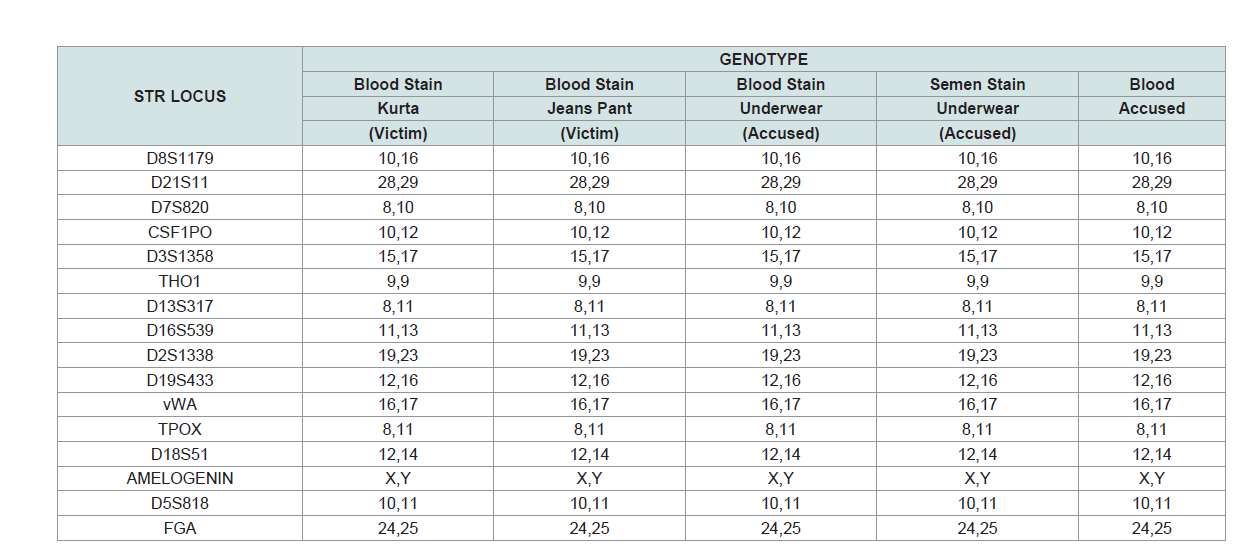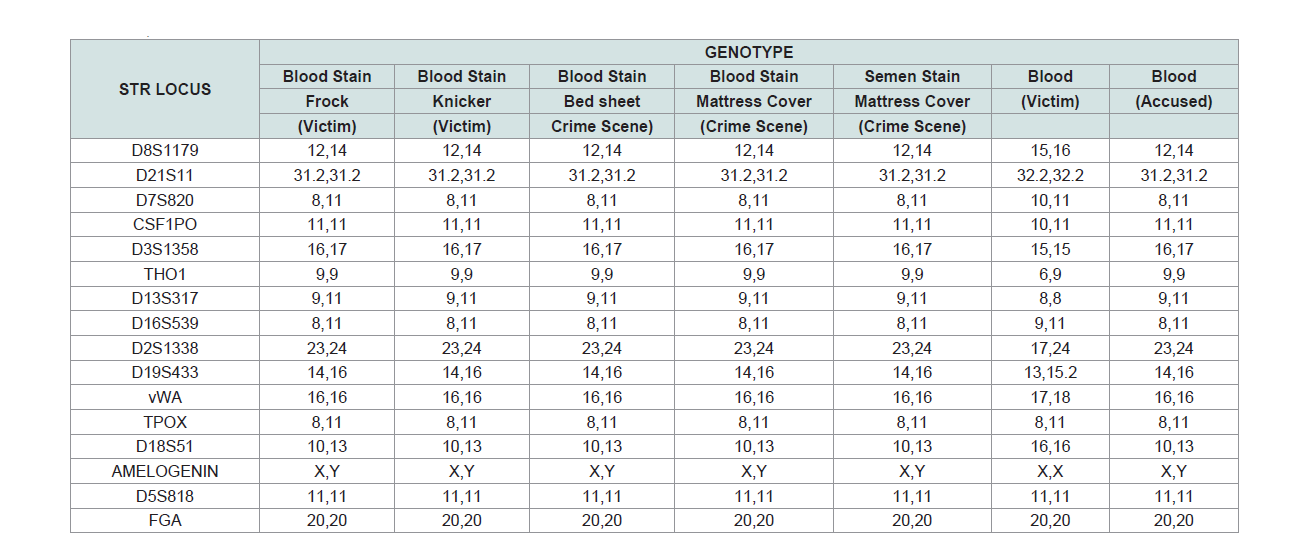Journal of Forensic Investigation
Download PDF
Research Article
Blood of Accused - Vital Scientific Evidence in Crime of Rape
Kudekar DY1*, Mahajan VB1*, More BP1, Kawade JR1 and Kulkarni KV2
1Regional Forensic Science Laboratory, Home Department, India
2Directorates of Forensic Science Laboratories, Home Department,
India
*Address for Correspondence: Kudekar DY, Regional Forensic Science Laboratory, Government of Maharashtra, Home Department, Dindori Road, Nashik - 440002, Maharashtra, India; Phone/Fax (O): 0253-2620573, Mob: 8898267006; E-mail: deepak.kudekar99@maharashtra.gov.in
Mahajan VB, Regional Forensic Science Laboratory, Home Department, India Email: vaishalimahajan.nagpur@gmail.com
Submission: 16-July-2020;
Accepted: 12-August-2020;
Published: 19-August-2020
Copyright: © 2020 Kudekar DY, et al. This is an open access article
distributed under the Creative Commons Attribution License, which
permits unrestricted use, distribution, and reproduction in any medium,
provided the original work is properly cited.
Abstract
Rape is a heinous crime and lot of rape crimes are registered
in Maharashtra day to day. In case of a minor victim, medical
examination plays important role to prove the rape. For the forensic
analysis, forensic science laboratory receives the samples collected
by medical officers during the medical examination of victim and
accused and the other samples of them like clothes, crime scene
articles seized by investigation agency. In the crime of rape, semen of
accused on clothes of victim or in genital parts of victim is always the
crucial scientific evidence which can prove the act of crime and can
led severe punishment by law. However, every time it is not possible
to obtain semen on articles as sometimes ejaculation of semen may
not be achieved by the culprit. In such situations, blood also plays
important role to connect the accused with the crime. We analyzed
two such cases where, DNA profiles obtained from blood detected
on victim’s clothes matched with DNA profiles of accused. However,
as the cases were belonged to rape, accused were adult and both
victims were minor, the transfer of blood of accused on their clothes
was astonishing. After studying medical examination report of both the
accused, it was found that they had penile injuries while attempting
the crime. So, in absence of semen; the DNA profile obtained from
blood on victim’s clothes found the crucial evidence in both the cases
which proved the involvement of accused in the crime.
Keywords
DNA; Polymerase chain reaction; Denaturation; STR; Genotyping
Introduction
Recently there has been tremendous rise in sexual offences
against women and more dangerous fact is that the number of minor
victims in such crimes is more. Census data from 2011 shows that
in India 472 million children below age of eighteen and out of them
225 million are girls [1]. Many times due to pressure and lack of
knowledge, these children fear to talk about atrocious crime. India
has taken lot of precautions since the Nirbhaya case happened and
made legal provision of new act “Protection of Children from Sexual
Offences Act 2012 (POCSO Act 2012)” and continuously monitoring
these cases [2]. To increase conviction rate, scientific evidence has lot
of importance and DNA evidence is the one of best evidence. If this
evidence is found, court can send culprit to rigorous imprisonment
considering DNA report.
While performing forensic analysis of exhibits seized in sexual
offences, though semen is absent in medical samples like vaginal
swab, pubic hair or on her clothes, if blood of accused is found on her
exhibits, it can play a vital evidence to prove the crime. This evidence
of blood is very much important in specifically minor victims.
Because in such crimes, it is observed that most of the times, accused
fails to intercourse and ejaculate semen because of smaller opening of
vagina of minor girl and he himself gets penile injuries while forceful
attempt. Blood detected in such cases is important to prove the crime
[3]. We solved such two cases in our forensic science laboratory.
In first case, registered in Nashik District, victim was 15 years
old. One day she went to buy grocery to nearby shop. A known boy
had taken advantage of her innocence and lured her. He took her in
secluded place and raped her forcefully without her consent.
In the second case, registered in Jalgaon District, victim was only
9 years old. She was a special child with mental illness while culprit
was 65 years old and he was her neighbor. The child was plying near
her home; accused called her in his home and tried to rape her on
iron bed.
In both the cases, investigation agencies sent seized cloths along
with medical samples of victims and accused to Regional forensic
science laboratory Nashik for forensic examination.
Materials and Methods
Prepfiler Express Kit (applied biosystem)
AmpFI STR Identifler kit (applied biosystem)
Forensic Buffer pH 8
Proteinase K
Phenol: Chloroform: Isoamyl Alcohol (100:100:4)
Isopropanol
1) Automate Express Forensic DNA System
Kit Used: Prep filer Express
2) PCR Thermal Cycler Machine, Capacity: 96 well x 0.2 ml PCR
Tubes
Capable of testing Temperatures: Denaturation, annealing and extension steps
Heating/ Cooling: Peltier based Temperature accuracy-±0.2 ˚C
Temperature accuracy-±0.2 ˚C
3) Genetic analyzer, Fragment size: 600bp
Number of markers: 16 for I- filer; Polymer: POP4
Oven Temp: 600 C, Column Size: 36 cm
Software: Gene Mapper
Steps used in analysis:
Detection of Blood and semen: In the first case, our laboratory had received clothes of victim, accused and medical samples like vaginal swabs, pubic hair, nail clippings and reference blood sample of victim and pubic hair, penile swab, nail clippings, reference blood sample of accused. During detection of all the exhibits, blood was detected only on kurta, jeans pant of victim and underwear of accused. Semen was detected on underwear of accused. No semen
was detected on victim’s clothes as well as medical samples.In the second case, our laboratory had received clothes of victim,
accused and crime scene bed sheet, mattress cover. Similarly, medical
samples of victim and accused collected by medical officer during
medical checkup. While analysis, the blood was detected on frock,
knicker of victim and also on bed sheet and cover of mattress. Semen
was detected on cover of mattress. No semen was detected on clothes
of victim and accused. Neither blood nor semen was detected on
medical samples of both.
Routine Kastle -Meyer solution was used for detection of blood [4,5].
Semen was detected on cover of mattress using acid phosphatase test [6].
Extraction of DNA: In the first case, the DNA was extraction
from blood detected on kurta, jeans pant of victim, underwear of
accused and semen detected on underwear of accused. In the second
case, DNA was extracted from blood detected on frock, knicker of
victim and bed sheet from crime scene and semen detected on cover
of mattress. The DNA extraction was done using Automate Express
machine using PrepFilerTM Express DNA extraction kit [7]. The
PrepFilerTMForensic DNA extraction Kit (Applied Biosystems, Foster
City, CA) is efficient for isolation of DNA from a variety of biological
samples that contain small quantities of biological material so that if
traces of undetected semen are present in blood on cloths or medical
samples, male DNA can be extracted from blood mixed semen using
this kit [7-9]. The protocol used for extraction was as follows.
1. Blood stains on all the positive articles were cut into small 1 x 1
mm pieces and were placed in 2ml micro centrifuge tube.
2. 500 μl Lysis buffer from PrepFiler Express F DNA extraction kit
(19) was added to all the sample tubes.
3. The sample tubes were kept on thermo shaker at 750 rpm at 70
˚C for 40 min.
4. The tubes were then centrifuged at 10,000 rpm for 2 min.
5. Cartridges from PrepFiler Express F DNA extraction kit were loaded to the cartridge rack in Automate Express DNA extraction system (20), Sample tubes, elution tubes and tips were loaded as per machine guidelines and the machine program was run as per the recommended machine protocol.
6. After completion of program, elution tubes containing extracted DNA in highly pure form were stored at 4˚C till the next PCR amplification process.
Many different methods are available for extraction of DNA.
Routine organic extraction Phenol/Chloroform extraction
method is quite sensitive method for the extraction of DNA from
wide variety of forensic samples [10]. This organic extraction method
was employed for extraction of DNA from reference blood samples
of accused and victim in both the cases. In organic extraction method,
samples were lysed using Forensic Buffer (pH 8), Proteinase K, and
Sodium Dodecyl Sulphate. Further samples were incubated for 2 hrs
at 56˚C and Phenol: Chloroform: Isoamyl alcohol previously prepared
solution was added. The aqueous layer containing DNA separated
and treated with 2 M Sodium Acetate and the DNA was precipitated
using chilled Isopropanol. Finally extracted DNA dissolved in TE
buffer (pH 7).
Quantification of DNA:
Extracted DNA was quantified using Quantifiler human DNA kit on 7500 Real Time PCR System (Applied Biosystems) according to the protocol [11,12]. Proper diluted DNA sample was used for further
PCR reaction.Polymerase chain reaction:
Quantified DNA of all the samples from both the cases was processed for PCR using AmpFlSTR® Identifiler® PCR amplification kit on Veriti Thermal Cycler of Applied Biosystems (Table 1 and 2) [13,14]. AmpFlSTRTM IdentifilerTM primers amplify the STR loci CSF1PO, D2S1338, D3S1358, D5S818, D7S820, D8S1179, D13S317, D16S539, D18S51, D19S433, D21S11, FGA, TH01, TPOX, vWA and gender marker Amelogenin.Master mix used for Polymerase Chain Reaction was-
AmpFISTR PCR reaction mix: 10.5 µl
AmpFISTR Primer Set: 5.5 µl
Polymerase: 0.55 µl
Volume of Master mix used: 15 µl
Volume of DNA sample: 10 µl
After PCR amplification denaturation was carried out using HiDi Formamide and Liz 600 size Standard.
STR Genotyping: After completion of PCR amplification of DNA, amplified DNA products were analyzed on 3500 Genetic
Analyzer and processed using Gene Mapper® ID-X Software V 1.5 according to manufacturer recommended procedure. Simultaneous amplification of 16 STR Loci was achieved [15-17]. DNA profiles obtained from above samples in both cases were interpreted and compared with each other.
Results and Discussion
In case no. 1 DNA profiles obtained from blood detected on
kurta, jeans pant of victim, underwear of accused and semen detected
on underwear of accused were found to be identical and from one
and the same source of male origin and matched with DNA profile
obtained from reference blood of accused ( Case no.1, Table no.1).
In case no.2 The DNA profiles obtained from blood detected on
frock and knicker of victim , bed sheet and cover of mattress from
crime scene and semen detected on cover of mattress from crime
scene found to be identical and from one and same source of male
origin and matched with DNA profile of reference blood of accused
(Case no.2, Table no.2).
Conclusion
As in both scenarios the victims of crime were minor girls. So,
during the act of sexual offence bleeding from genitals of victim is
natural. While analysis, the forensic expert probably expects either
blood of victim or semen of accused on garments as well as on crime
scene. But every time, it doesn’t happen. Many times, accused tries
for intercourse but being minor the vaginal opening is small and
victim cries due to pain so, accused himself gets penile injuries in
trying forceful intercourse, his blood may found on crime scene
and garments of victim and accused. In both the cases analyzed in
our laboratory, we got male DNA profiles from blood detected on
clothes. When we inquired injury report of accused, it showed penile
injuries while attempting the rape. In absence of semen on clothes or
medical samples of victim; the DNA profile obtained from blood of
accused itself proved that the profiles belong to accused, in addition
to this, medical injury reports also support that both culprits got
penile injuries. It is definitely a sufficient evidence to prove the guilt
of accused in the court.



